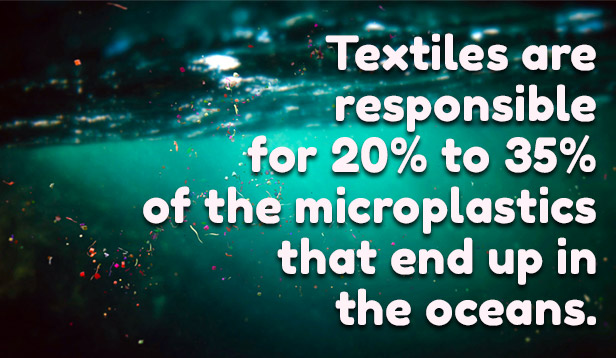Product Hub December 13, 2021
Innovators Seek $650,000 Prize to Curb Microplastic Pollution
The Microfiber Innovation Challenge announced 12 finalists with solutions to stop clothing from shedding microfibers, which end up polluting the oceans.
What if the answer to the apparel industry’s microfiber pollution problem could be found in a glass of orange juice – or the tentacle of a squid?
Innovators from around the world are seeking novel ways to keep microplastics shed from clothing out of the oceans, and Conservation X Labs, a Washington, D.C.-based tech company, is offering $650,000 to the team that presents the best solution to this environmental conundrum. The company recently announced 12 finalists in its Microfiber Innovation Challenge.

Millions of tiny fibers are shed from clothing when it’s worn or washed, which has become an issue because so much apparel is made from synthetic materials. Textiles are responsible for 20% to 35% of the microplastics that end up in the oceans, according to management consulting firm McKinsey & Company. Putting an end to microfiber pollution would require a significant transformation in the textile and clothing production process, according to Conservation X Labs. With so much apparel in the promo products industry made – at least in part – from polyester and other synthetics, it’s worth keeping an eye on how the greater apparel industry is addressing the issue of microfiber-shedding.
📣 Announcing the #MicrofiberInnovation Challenge finalists!
— Conservation X Labs (@conservationx) December 13, 2021
These 12 innovations are creating a more sustainable future by changing how we make and manufacture our clothing and textiles. https://t.co/T6iFAB0MLR pic.twitter.com/mmRVVcteXT
“Big challenges, like microfiber plastic pollution, require thinking big,” said Stephanie Benedetto, CEO and co-founder of Queen of Raw, a marketplace for sustainable textiles and one of 30 organizations supporting Conservation X Labs’ challenge. “Working together with these 12 innovative solutions allows us to build scalable solutions that make sense for people, planet and profit. So, we can not only survive today, but thrive tomorrow.”
The Microfiber Innovation Challenge invited scientists, engineers, biologists, entrepreneurs and innovators across the world to submit applications showing how their innovations can solve the issue at the source.
“We’re excited to provide critical support to the real solutions, products and tools that are addressing the exponentially growing plastic pollution crisis.” Paul Bunje, Conservation X Labs
“These are some of the most revolutionary innovations that are needed to create a more sustainable future,” said Paul Bunje, co-founder of Conservation X Labs. “We’re excited to provide critical support to the real solutions, products and tools that are addressing the exponentially growing plastic pollution crisis.”
The finalists were chosen by an external panel of experts in sustainable apparel, microplastics research and innovation accelerators. The innovations were judged on feasibility, potential for growth, environmental impact and the novelty of their approach.
Here are the 12 finalists:
- AlgiKnit, Brooklyn, NY: Eco-conscious, renewable yarns derived from kelp seaweed, one of the most regenerative organisms on the planet.
- AltMat, Ahmedabad, India: Alternative materials that repurpose agricultural waste into versatile and high-performing natural fibers.
- BioHastalex, London, U.K.: An innovation initially designed for skin regeneration and wound healing is being applied to fibers and fabrics. Textile made from graphene-based fibers are nontoxic, biodegradable, recyclable, don’t shed and can be waterproofed without additives. Graphene is also incredibly strong and lightweight.
- Kintra Fibers, Brooklyn, NY: A proprietary bio-based and compostable polymer that’s optimized for synthetic textile production, providing apparel brands with a strong, soft and cost-effective cradle-to-cradle material.
- Mango Materials, Oakland, CA: This innovative manufacturing technology turns waste carbon emissions into biodegradable biopolyester fibers.
- Natural Fiber Welding, Peoria, IL: Bonding networks holding natural fibers together are engineered to control a yarn’s form and enhance fabric performance features, including dry time and moisture-wicking ability.
- Orange Fiber, Catania, Italy: This innovation incorporates a patented process to create sustainable fabrics from the byproducts of citrus juice.
- PANGAIA x MTIX Microfiber Mitigation, West Yorkshire, U.K.: A novel application of MTIX’s multiplexed laser surface enhancement technology modifies the surfaces of fibers within a fabric to prevent microfiber shedding.
- Spinnova, Jyväskylä, Finland: Mechanically refined wood or waste is turned into a textile fiber without any harmful chemicals in the manufacturing process.
- Squitex, Philadelphia, PA: This innovation uses genetic sequencing and synthetic biology to produce a unique protein structure originally found in the tentacles of the squid.
- TreeKind, London, U.K.: A new plant-based leather alternative made from urban plant waste, agricultural waste and forestry waste that uses less than 1% of the water compared to leather production.
- Werewool Fibers, New York City: This innovation involves using biotechnology to design new fibers with specific structures that mimic aesthetic and performance properties found in nature.
Winners will be unveiled at an event in early 2022 as part of a solutions fair and awards ceremony. Conservation X Labs issues global competitions with monetary prizes each year to find the best solutions to specific conservation problems. Challenge topics are chosen by identifying opportunities where technology and innovation can address threats to ecosystems and the environment.

Product Hub
Find the latest in quality products, must-know trends and fresh ideas for upcoming end-buyer campaigns.
